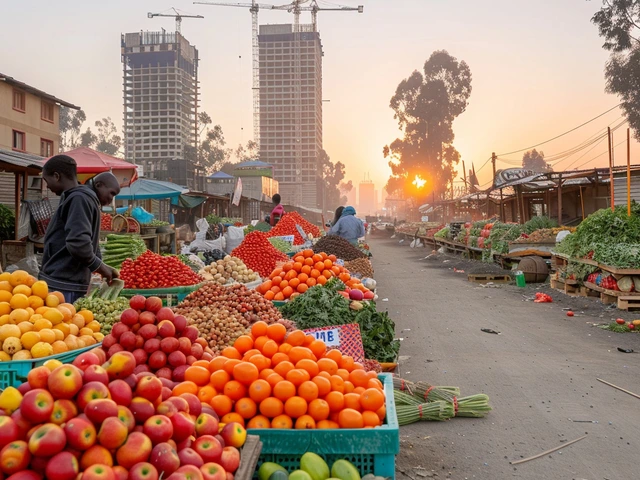Understanding the employment landscape in Ethiopia is crucial, especially as the country continues to grow and transform. Nestled in the Horn of Africa, Ethiopia boasts a rich history and a diverse economy, yet numerous challenges and opportunities shape its job market.
From bustling cities like Addis Ababa to serene rural areas, the dynamics of employment can vary significantly. Whether you're looking at agriculture's dominance or the rise of new sectors like manufacturing and services, there is much to learn about work in this vibrant nation.
Let's take a journey through the current state of employment in Ethiopia, shedding light on the profound factors at play and exploring what the future might hold for the Ethiopian workforce.
- Employment Overview
- Key Sectors for Jobs
- Urban vs Rural Employment
- Challenges in the Labor Market
- Government and International Efforts
- Future Prospects
Employment Overview
Understanding the current employment situation in Ethiopia provides valuable insights into both its challenges and opportunities. As of 2024, Ethiopia's labor market includes a vast and diverse population, with millions engaged in various occupations across the country. The total labor force comprises approximately 54 million people, a figure that represents more than half the nation's population. This large workforce is a critical element in the country's economic growth story.
The agricultural sector remains the backbone of Ethiopia's job market, employing around 70% of the workforce. This sector includes smallholder farmers engaged in subsistence farming, alongside larger commercial farming operations. Coffee, a crucial export product, alongside crops such as teff and maize, plays a significant role in providing employment opportunities. The reliance on agriculture highlights the country's vulnerability to climate change and economic shocks, impacting job security for millions.
While agriculture dominates, other sectors are slowly gaining ground. The manufacturing sector, for instance, has shown promising growth. Industrial parks, set up across the country, have become hubs for textile and garment manufacturing, creating employment for tens of thousands. Companies from China and other nations have invested in these industrial parks, creating a ripple effect on job creation.
The services sector is another area of progress, witnessing rapid expansion in recent years. This sector includes finance, telecommunications, and retail, among others. Addis Ababa, the capital city, has seen a surge in banking and telecommunications jobs, driven by increased mobile phone penetration and financial inclusion initiatives. Hotels and tourism-related businesses also provide numerous employment opportunities, especially with Ethiopia being a gateway to Africa's historical and cultural treasures.
The informal sector in Ethiopia is significant, employing a substantial portion of the labor force. Street vendors, small traders, and others working without formal contracts constitute a vital part of the economy. This sector, while flexible, faces challenges in terms of job security and access to social protection. Often, those working in the informal economy do not have benefits such as health insurance or retirement plans, making them vulnerable to economic fluctuations.
Youth unemployment remains a critical issue, with many young Ethiopians struggling to find sustainable employment despite their educational qualifications. This mismatch between skills and job market demands means that new graduates often face prolonged periods of joblessness. Initiatives to enhance technical and vocational training are underway, aiming to bridge this gap and better prepare the youth for the labor market.
The Ethiopian government has recognized the importance of addressing these employment challenges. Significant efforts have been made to create job opportunities through various national plans and programs. For instance, the
Key Sectors for Jobs
Ethiopia is a nation with a dynamic and diverse economy, characterized by a variety of key sectors that provide employment opportunities to millions. The major sectors driving job creation include agriculture, manufacturing, and services, each playing a unique role in shaping the country's labor market.
Agriculture remains the backbone of Ethiopia's economy, employing a significant portion of the population. According to recent data, around 70% of Ethiopians work in agriculture, primarily in subsistence farming. Coffee, a vital crop, stands as one of the country's largest exports, supporting countless livelihoods. However, the sector faces challenges such as climate change and limited access to modern technology, which impact productivity.
Agriculture
The agricultural sector is central to Ethiopia's economic framework, producing essential commodities like coffee, grains, pulses, and oilseeds. Efforts to modernize agriculture are ongoing, with initiatives focused on improving irrigation techniques and promoting sustainable farming practices. Despite the sector's dominance, there's a need to address issues like soil fertility and water scarcity, which hinder growth.
One interesting fact is that coffee exports accounted for over 30% of Ethiopia's foreign exchange earnings in the last year. This highlights the sector's vital role in the national economy. As Dr. Sileshi Getahun, an agricultural expert, remarked,
"Investing in agricultural technology and infrastructure can significantly uplift the livelihoods of rural populations and boost overall productivity."
Manufacturing
With the Ethiopian government's ambitious plans to transform the economy, the manufacturing sector has witnessed remarkable growth. The establishment of industrial parks, such as the Hawassa Industrial Park, has attracted foreign investments and created numerous jobs. Textiles and apparel production are notable beneficiaries of this growth, employing thousands and contributing significantly to export revenue.
Moreover, the government's focus on expanding this sector aligns with its vision of becoming a middle-income country by 2025. The challenge lies in ensuring that the growth within manufacturing translates to sustainable employment opportunities. The sector's success relies heavily on continued investment in infrastructure and addressing gaps in supply chain efficiency.
Services
The services sector has been expanding rapidly, driven by various factors, including urbanization, technological advances, and an increasing demand for diverse services. Sub-sectors such as banking, telecommunications, tourism, and information technology have emerged as significant contributors to job creation.
Tourism, in particular, holds immense potential. Ethiopia's rich cultural heritage, historical sites, and natural beauty attract visitors worldwide. Yet, harnessing this potential requires improving infrastructure, enhancing marketing efforts, and ensuring tourist safety. The potential revenue from tourism can provide a substantial economic boost, creating jobs across several related industries.
The telecommunications industry, spearheaded by the state-owned Ethio Telecom and recent market liberalization efforts, also represents a crucial employment driver. Expanding network coverage and introducing competitive services can open up opportunities for innovation and job creation in related fields.
Future Outlook
Looking forward, understanding and addressing the challenges in these key sectors is vital for sustainable job creation and economic growth. Ethiopia's strategic focus on agro-industrialization, expanding manufacturing, and enhancing service delivery shows promise, but it requires cohesive policies and continuous investment.
The government's commitment to improving education and vocational training is also crucial. Equipping the labor force with the necessary skills will ensure they meet the evolving demands of these sectors. It is this blend of traditional sectors and emerging industries that will define the future of employment in Ethiopia.

Urban vs Rural Employment
In Ethiopia, the distinction between urban and rural employment reveals some fascinating aspects of the nation's labor market. Urban areas are often characterized by diverse job opportunities and a concentration of industries, while rural regions remain primarily driven by agriculture.
In the cities, particularly in the capital Addis Ababa, there has been a notable shift towards jobs in the service sector. Financial services, telecommunications, and retail have gained prominence, reflecting the country's efforts towards modernization and economic diversification. Manufacturing is also on the rise, creating a demand for both skilled and unskilled labor. The expansion of industrial parks and special economic zones is one step towards balancing employment opportunities.
On the other hand, rural Ethiopia largely depends on agriculture, which employs approximately 70% of the country's workforce. Crops like coffee, teff, and maize are staples, but farmers often face challenges such as unpredictable weather conditions and limited access to modern farming techniques. Despite these hurdles, agriculture remains the backbone of the rural economy and a critical sector for employment.
The gap between urban and rural employment is also evident in terms of income levels and living standards. Urban workers generally enjoy better employment benefits and higher wages compared to their rural counterparts. This disparity can be attributed to the availability of education and skill development programs in urban areas.
A World Bank report highlights that:
"the rural-urban divide in Ethiopia continues to impact not just employment opportunities but also access to essential services such as healthcare and education."This divide means that people in urban areas often have more access to resources that can improve their quality of life as well as their work opportunities.
Efforts are being made to bridge this gap. The government has initiated various programs aimed at rural development, including infrastructure improvements and agricultural support. International organizations are also contributing through grants and technical assistance to enhance productivity in rural regions.
Despite these initiatives, the journey towards balanced employment opportunities is long. It's essential to continuously support both urban and rural development to create a more inclusive labor market. By understanding and addressing the unique needs of these areas, Ethiopia can foster an environment where all its citizens can thrive.
Challenges in the Labor Market
Ethiopia's labor market faces a variety of significant challenges that affect job creation and employment stability. One of the most pressing issues is the high rate of youth unemployment. With over 60% of the population under the age of 25, finding meaningful work for young people is a critical concern. This demographic bulge puts pressure on the job market and highlights the need for effective vocational training programs and educational reforms.
An additional challenge is the informal economy. Many Ethiopians work in jobs that are not officially registered, which means they do not have access to social security benefits, worker protections, or proper income reporting. The informal sector can account for up to 80% of the total employment in some areas, leading to unstable incomes and a lack of job security.
Rural-urban migration also poses a significant problem. As people move from rural areas to cities in search of better opportunities, urban areas struggle to provide adequate infrastructure, housing, and social services. This influx can lead to overcrowded cities and strain municipal resources, exacerbating unemployment and underemployment in urban centers.
Lack of industry diversification is another hurdle. Agriculture remains the dominant sector, employing around 70% of the workforce. However, reliance on agriculture makes the economy vulnerable to climatic changes, pests, and fluctuating global market prices. Efforts to diversify into sectors such as manufacturing and services are ongoing but face numerous obstacles, including inadequate infrastructure and insufficient investment.
Additionally, there is the issue of gender disparity in the labor market. Women often face significant barriers to employment, including cultural norms, lack of education opportunities, and limited access to resources. Although progress has been made in recent years, many women still find it challenging to enter and thrive in the formal job market.
Educational mismatches add another layer of difficulty. There is often a gap between the skills taught in educational institutions and those demanded by employers. This mismatch results in graduates struggling to find jobs that match their qualifications, creating a need for better alignment between education and labor market needs.
Political instability and periodic conflicts can severely disrupt economic activities and cause job losses. Political factors such as changes in policy, governance issues, and regional conflicts also impact the labor market's stability. For instance, unrest in certain regions can halt business operations and deter foreign investment, which is critical for job creation and economic growth.
Finally, limited access to financial services hinders the growth of small and medium-sized enterprises (SMEs). SMEs are vital for job creation, but many entrepreneurs face challenges in securing the necessary funding to start or expand their businesses. Enhancing access to credit and fostering a supportive business environment are essential to overcoming this challenge.
As noted by the World Bank, “Economic reforms and private sector engagement are pivotal to overcoming these structural challenges and creating a more inclusive labor market in Ethiopia.”

Government and International Efforts
The Ethiopian government has undertaken numerous measures to stimulate job creation and economic growth. Central to these efforts is the 'Growth and Transformation Plan' (GTP), designed to diversify the economy and reduce poverty. Since its inception, the GTP has focused on strengthening the agricultural sector, which employs the majority of the populace, while also promoting the expansion of manufacturing and services. This multi-faceted approach aims to create a more balanced and robust economic landscape.
International organizations and foreign governments also play an integral role in bolstering Ethiopia’s employment sector. Partnerships with entities like the World Bank and the United Nations Development Programme (UNDP) offer vital support through funding and expertise. For example, the World Bank’s programs in Ethiopia focus on enhancing educational quality and vocational training, which are essential for equipping the workforce with necessary skills. As a result, there has been visible improvement in sectors like textile manufacturing and technology services.
One illustrative success is the establishment of Industrial Parks across Ethiopia. These parks are designed with the aim of attracting foreign investments and creating job opportunities for locals. For instance, the Hawassa Industrial Park has generated thousands of jobs by hosting textile and garment factories. This initiative reflects Ethiopia’s strategy to become a hub for light manufacturing in Africa, drawing lessons and investments from international giants while creating employment.
The government also collaborates with initiatives such as 'Jobs Compact,' a partnership involving the Ethiopian government, the European Union, and the World Bank. This initiative is dedicated to creating employment opportunities for both Ethiopian citizens and refugees residing within the country. As cited by a senior official at Jobs Compact,
"We envision a future where every able citizen has the means to earn a living and contribute positively to society."Efforts like these showcase a strong commitment to not only foster job creation but also promote social inclusivity.
Moreover, technical and vocational education and training (TVET) programs have been significantly enhanced with international assistance. Programs from countries such as Germany and China provide resources for expanding technical education, ensuring that young Ethiopians can acquire skills that are in demand in the global market. This approach bridges the gap between education and employment and aligns with Ethiopia's vision of transitioning to a middle-income economy.
One must not overlook the role of non-governmental organizations (NGOs) in contributing to employment growth. Organizations like Oxfam and Save the Children run various programs aimed at improving livelihoods in rural areas, focusing particularly on vulnerable populations such as women and youth. These programs offer training in entrepreneurial skills, providing seed funding for small businesses, and advocating for better market access. Their grassroots efforts are pivotal in communities that rely heavily on agriculture yet face challenges due to market volatility and climate change.
Future Prospects
Looking forward, Ethiopia's employment landscape offers a mix of promise and uncertainty. The nation has experienced significant growth over the past few years, but the journey is far from over. With one of the fastest-growing economies in Africa, Ethiopia's future job market is likely to be shaped by a combination of governmental policies, international investments, and grassroots initiatives. Ethiopia's jobs will see considerable evolution, influenced by several key forces.
One area that holds substantial potential is the manufacturing sector. The government has been actively promoting industrial parks, aiming to position Ethiopia as a hub for light manufacturing. These efforts could lead to the creation of millions of jobs, especially for the youth. Adding to this, Ethiopia's strategic position makes it a viable option for export-oriented manufacturing.
"Ethiopia's manufacturing sector, especially textiles and garments, is very promising and could employ a significant portion of the labor force," notes a report by the World Bank.The service industry is another sector poised for growth. Edging away from a traditionally agrarian society, Ethiopia is investing in technology and innovation. The information and communications technology (ICT) sector could become a major employer, attracting international tech companies to set up operations in the country.
Here is an interesting prospect for the agricultural sector too, which employs a large percentage of the population. Initiatives aimed at modernizing agriculture through technology, better practices, and irrigation projects are underway. These improvements could streamline farming processes, leading to better yields and, interestingly, more job opportunities in agro-processing and distribution. Entrepreneurs might find fertile ground in agribusiness ventures as well.
Yet, Ethiopia must navigate numerous challenges to foster a thriving job market. Political stability, for instance, plays a crucial role in attracting investment and ensuring consistent job creation. Ongoing conflicts and social unrest can deter economic progress, making it essential for the government to prioritize peace and stability. Another factor is education. Equipping the workforce with necessary skills is key. Investments in vocational training and higher education tailored to market needs can ensure that Ethiopians are well-prepared for future jobs.
International partnerships also stand to significantly impact the employment scenario. Programs supported by organizations like the African Development Bank and USAID are already making strides in various sectors. By enhancing infrastructure, supporting small and medium enterprises (SMEs), and funding educational initiatives, these partnerships provide a framework for sustained growth and job creation. The local and diaspora private sectors are adding to this, with Ethiopians abroad investing back home, bringing not only capital but also skills and knowledge.
The outlook for Ethiopia's labor market is cautiously optimistic. With concerted efforts from all sectors of society – government, private, and development partners – the country can harness its potential. This would mean not just more jobs, but better jobs, offering prosperity to more Ethiopians. As Ethiopia stands on the threshold of its next growth phase, the opportunities for employment could redefine the nation's economic and social landscape.

 Accountant Salaries in Ethiopia: A Detailed Analysis
Accountant Salaries in Ethiopia: A Detailed Analysis
 Exploring the Safety of Living in Ethiopia: Insights and Tips
Exploring the Safety of Living in Ethiopia: Insights and Tips
 Making Money on YouTube in Ethiopia: A Practical Guide
Making Money on YouTube in Ethiopia: A Practical Guide
 Top Countries for High-Paying Pharmacist Jobs
Top Countries for High-Paying Pharmacist Jobs
 Navigating Business Risks in Ethiopia: Opportunities and Challenges
Navigating Business Risks in Ethiopia: Opportunities and Challenges
Chirag P
July 10, 2024 AT 17:40Seeing the employment figures for Ethiopia, it’s clear that agriculture still carries the bulk of the job load. The sector’s dominance means any shock to weather or markets ripples through millions of households. At the same time, the nascent manufacturing parks are beginning to carve out decent wages for urban workers. If policymakers keep pushing vocational training, the transition from farm to factory can become less painful.
RUBEN INGA NUÑEZ
July 17, 2024 AT 16:20The informal sector still accounts for a huge share of jobs, despite lacking protections.
Michelle Warren
July 24, 2024 AT 15:00Honestly, the stats read like a saga of missed chances-young Ethiopians are stuck in a loop of graduate‑degree‑but‑no‑job, a classic case of “over‑educated but under‑employed”. The government’s push for tech hubs sounds shiny, yet the rural classrooms still lack basic textbooks. If the vibe doesn’t change, the talent drain will keep flowing out of the country.
Christopher Boles
July 31, 2024 AT 13:40It’s encouraging to note that industrial parks are finally humming, giving city dwellers a foothold in steady jobs. With each new textile line, there’s a chance for apprentices to learn hands‑on skills that the education system hasn’t covered. Keep the optimism alive-small wins add up to big change.
Crystal Novotny
August 7, 2024 AT 12:20One could argue that the focus on agriculture is a nostalgic trap; modern economies rarely rely on a single sector for growth. Yet Ethiopia clings to the past as if it were a comfort blanket. The data whisper that diversification is not just an option but a necessity.
Reagan Traphagen
August 14, 2024 AT 11:00The narrative that Ethiopia is on a steady upward trajectory is nothing but propaganda fed by foreign investors. Behind the glossy reports lies a labor market crippled by corruption, forced migrations, and a government that pretends to care while siphoning resources. Anyone who buys into the “growth story” is either naïve or complicit.
mark sweeney
August 21, 2024 AT 09:40i think the whole idea of “industrial parks” is just a glossy label for cheap labor farms. sure they create jobs but they also lock workers into low pay cycles. we need real skill building not just assembly line drills.
randy mcgrath
August 28, 2024 AT 08:20When we contemplate the future of Ethiopian employment, we must balance the measurable metrics with the lived experiences of workers. Statistics can tell us how many are employed, but they cannot capture the dignity or insecurity behind each paycheck. A holistic view respects both numbers and narratives.
Frankie Mobley
September 4, 2024 AT 07:00The government’s partnership with foreign technical schools is a solid step. When trainees return with hands‑on knowledge, local factories can finally upgrade their processes without relying on imported expertise.
ashli john
September 11, 2024 AT 05:40Great to see the push for vocational schools it will give youths real options not just theory they need more hands on training and community support to keep them engaged
Kim Chase
September 18, 2024 AT 04:20i think we should not overlook the small scale farms they are a big part of the econmy even if they dont have big numbers they feed a lot of the country and give jobs to many families
David Werner
September 25, 2024 AT 03:00The shadowy forces behind the “Jobs Compact” are just a front, a smoke screen to hide the real agenda of population control. Every new industrial park is a trap, luring workers into a web of surveillance and debt slavery. Wake up, Ethiopia!
Paul KEIL
October 2, 2024 AT 01:40From a macro‑economic standpoint, the labor market elasticity is being artificially suppressed by structural rigidities in regulatory frameworks. The fiscal stimulus lacks targeted sectoral subsidies, resulting in sub‑optimal allocation of human capital resources.
Horace Wormely
October 9, 2024 AT 00:20While the article cites a 70% agricultural employment figure, the source data actually reports 68.9%, indicating a rounding error that could mislead readers about the sector’s exact share.
christine mae cotejo
October 15, 2024 AT 23:00The Ethiopian labor tapestry is woven with threads of ancient toil and modern ambition.
From the highlands where terraced fields echo with the rhythm of harvest, to the humming factories of Hawassa, each sector tells a story of resilience.
Agriculture, still the heart of the economy, feeds not only stomachs but also hopes, despite being battered by erratic rains.
Yet the same rain that nourishes crops also washes away the fragile livelihoods of countless families, exposing the sector’s vulnerability.
Manufacturing, a newcomer on the stage, flickers like a candle in a windstorm, offering light but demanding careful shelter.
Industrial parks sprout like oases, promising employment, yet they require a steady stream of skilled hands to truly flourish.
The services sector, with its banks and telecom towers, is the nervous system that connects the nation, accelerating the flow of information and money.
Youth unemployment remains a stark counterpoint, a silent protest of a generation armed with diplomas but denied doors.
Vocational training centers, though sprouting across the country, often lack the curriculum depth to match industry needs.
International aid pours in, but without coherent coordination, it sometimes creates parallel tracks rather than a unified road.
Gender disparity lingers, as cultural expectations still tether many women to unpaid domestic labor, limiting their entry into formal markets.
Urban migration swells cities, stretching housing and services thin, while rural communities watch their youth depart, leaving aging hands behind.
A balanced policy mix-investing in irrigation, expanding technical education, and fostering private‑public partnerships-could bridge these gaps.
If such a roadmap is embraced, Ethiopia could transform its labor force from a demographic burden into a dynamic engine of growth.
Until then, the nation's employment narrative remains a work in progress, penned by countless hands striving for a brighter tomorrow.
Douglas Gnesda
October 22, 2024 AT 21:40The recent World Bank metrics show a 3.2% rise in formal sector jobs, but the underlying skill gap remains unaddressed; upskilling initiatives must align with market demand to convert those numbers into sustainable careers.
Abhijit Pimpale
October 29, 2024 AT 19:20Data shows 70% agriculture employment; the rest is fragmented informal work.
Eric DE FONDAUMIERE
November 5, 2024 AT 18:00Yo! Let’s get those youth into tech bootcamps fast-skill up now, job later!
Pauline Herrin
November 12, 2024 AT 16:40While the article presents a comprehensive overview, it fails to critically assess the efficacy of current policy measures, thereby offering a superficial analysis of Ethiopia’s employment challenges.
pradeep kumar
November 19, 2024 AT 15:20The so‑called “development plans” are just a façade; without transparency they’ll never deliver real jobs.